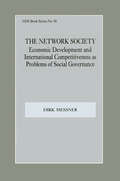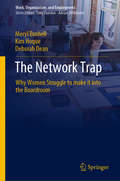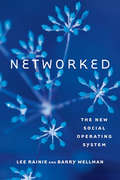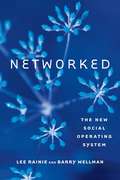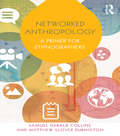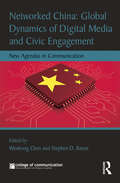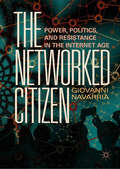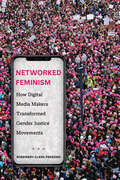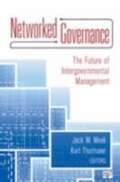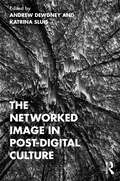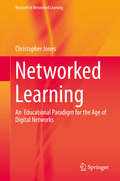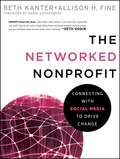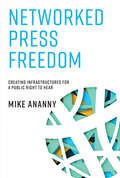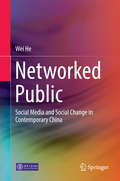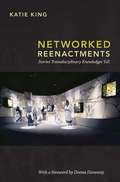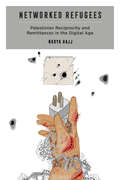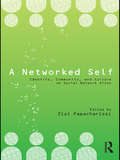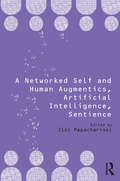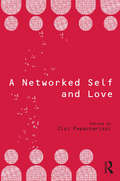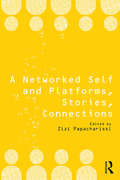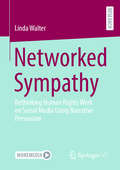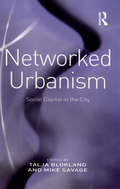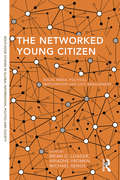- Table View
- List View
The Network Society: Economic Development and International Competitveness as Problems of Social
by Dirk MessnerThe author argues that the countries that, at the end of the 20th century, have economic, social and ecological success will not be unleashed market economies but "active and learning societies" that attempt to solve their problems via an organizational and governance-related pluralism.
The Network Trap: Why Women Struggle to Make it into the Boardroom (Work, Organization, and Employment)
by Meryl Bushell Kim Hoque Deborah DeanAs we begin the third decade of the twenty-first century, women have entered the workplace in unprecedented numbers, are now outperforming men in terms of educational qualifications, and are excelling across a range of professional fields. Yet men continue to occupy the positions of real power in large corporations.This book draws on unique, unprecedented access to Chairs of FTSE 350 Chairs, boardroom aspirants and executive head-hunters, to explain why this is the case.The analysis it presents establishes that the relative absence of women in boardroom roles is not explained by their lack of relevant skills, experience or ambition, but instead by their exclusion from the powerful male-dominated networks of key organisational decision-makers. It is from within these networks that candidates are sourced, endorsed, sponsored, and championed. Yet women’s efforts to penetrate these networks are instead likely to trap them into network relationships that will be of little value in helping them to fulfil their career aspirations.The analysis also identifies why women struggle to gain access to these networks, and in doing so, it demonstrates that the network trap in which women find themselves will not be overcome simply by encouraging them to change their networking behaviours. Instead, there is a need for a fundamental reconsideration of how boardroom recruitment and selection is conducted and regulated, to ensure the development of a more open, transparent and equitable process.
Networked: The New Social Operating System (Contemporary Studies In Sociology Ser. #Vol. 15)
by Lee Rainie Barry WellmanHow social networks, the personalized Internet, and always-on mobile connectivity are transforming—and expanding—social life.Daily life is connected life, its rhythms driven by endless email pings and responses, the chimes and beeps of continually arriving text messages, tweets and retweets, Facebook updates, pictures and videos to post and discuss. Our perpetual connectedness gives us endless opportunities to be part of the give-and-take of networking.Some worry that this new environment makes us isolated and lonely. But in Networked, Lee Rainie and Barry Wellman show how the large, loosely knit social circles of networked individuals expand opportunities for learning, problem solving, decision making, and personal interaction. The new social operating system of “networked individualism” liberates us from the restrictions of tightly knit groups; it also requires us to develop networking skills and strategies, work on maintaining ties, and balance multiple overlapping networks.Rainie and Wellman outline the “triple revolution” that has brought on this transformation: the rise of social networking, the capacity of the Internet to empower individuals, and the always-on connectivity of mobile devices. Drawing on extensive evidence, they examine how the move to networked individualism has expanded personal relationships beyond households and neighborhoods; transformed work into less hierarchical, more team-driven enterprises; encouraged individuals to create and share content; and changed the way people obtain information. Rainie and Wellman guide us through the challenges and opportunities of living in the evolving world of networked individuals.
Networked
by Lee Rainie Barry WellmanDaily life is connected life, its rhythms driven by endless email pings and responses, the chimes and beeps of continually arriving text messages, tweets and retweets, Facebook updates, pictures and videos to post and discuss. Our perpetual connectedness gives us endless opportunities to be part of the give-and-take of networking. Some worry that this new environment makes us isolated and lonely. But in Networked, Lee Rainie and Barry Wellman show how the large, loosely knit social circles of networked individuals expand opportunities for learning, problem solving, decision making, and personal interaction. The new social operating system of "networked individualism" liberates us from the restrictions of tightly knit groups; it also requires us to develop networking skills and strategies, work on maintaining ties, and balance multiple overlapping networks. Rainie and Wellman outline the "triple revolution" that has brought on this transformation: the rise of social networking, the capacity of the Internet to empower individuals, and the always-on connectivity of mobile devices. Drawing on extensive evidence, they examine how the move to networked individualism has expanded personal relationships beyond households and neighborhoods; transformed work into less hierarchical, more team-driven enterprises; encouraged individuals to create and share content; and changed the way people obtain information. Rainie and Wellman guide us through the challenges and opportunities of living in the evolving world of networked individuals.
Networked Anthropology: A Primer for Ethnographers
by Samuel Gerald Collins Matthew Slover DuringtonThe advent of social media offers anthropologists exciting opportunities to extend their research to communities in fresh ways. At the same time, these technological developments open up anthropological fieldwork to different hazards. Networked Anthropology explores the increasing appropriation of diverse media platforms and social media into anthropological research and teaching. The chapters consider the possibilities and challenges of multimedia, how network ecologies work, the ethical dilemmas involved, and how to use multimedia methodologies. The book combines theoretical insights with case studies, methodological sketches and pedagogical notes. Drawing on recent ethnographic work, the authors provide practical guidance in creative ways of doing networked anthropology. They point to the future of ethnography, both inside and outside the classroom, and consider ways in which networked anthropology might develop.
Networked China: New Agendas in Communication (New Agendas in Communication Series)
by Stephen D. Reese Wenhong ChenThe Internet and digital media have become conduits and locales where millions of Chinese share information and engage in creative expression and social participation. This book takes a cutting-edge look at the impacts and implications of an increasingly networked China. Eleven chapters cover the terrain of a complex social and political environment, revealing how modern China deals with digital media and issues of censorship, online activism, civic life, and global networks. The authors in this collection come from diverse geographical backgrounds and employ methods including ethnography, interview, survey, and digital trace data to reveal the networks that provide the critical components for civic engagement in Chinese society. The Chinese state is a changing, multi-faceted entity, as is the Chinese public that interacts with the new landscape of digital media in adaptive and novel ways. Networked China: Global Dynamics of Digital Media and Civic Engagement situates Chinese internet in its complex, generational context to provide a full and dynamic understanding of contemporary digital media use in China. This volume gives readers new agendas for this study and creates vital new signposts on the way for future research. .
The Networked Citizen: Power, Politics, and Resistance in the Internet Age
by Giovanni NavarriaThis book investigates the changing meanings of power and politics in the Internet age and questions whether the political category of the citizen still has a meaningful role to play in the highly-mediated dynamics of an increasingly networked world. To answer such questions, the book analyses and compares the impact of the Internet on the relationship between state, citizens, and politics in three countries: the USA, Italy, and China. The book’s journey starts in the mid-90s and ends in 2016. It pays particular attention to Obama 2008 and Trump 2016 presidential campaigns, the ascendance to power in Italy of the anti-establishment Five Star Movement, and to the enduring Chinese government’s struggle to control the Internet public opinion. The book challenges the traditional understanding of power through which the strong typically prevails over the weak. This leads to a clearer understanding of the wider role citizens can play (and must play) in a networked political sphere, while it also warns the reader on the many risks citizens face in a post-truth world.The book challenges the traditional understanding of power through which the strong typically prevails over the weak. This leads to a clearer understanding of the wider role citizens can play (and must play) in a networked political sphere.
Networked Feminism: How Digital Media Makers Transformed Gender Justice Movements
by Rosemary Clark-ParsonsNetworked Feminism tells the story of how activists have used media to reconfigure what feminist politics and organizing look like in the United States. Drawing on years spent participating in grassroots communities and observing viral campaigns, Rosemary Clark-Parsons argues that feminists engage in a do-it-ourselves feminism characterized by the use of everyday media technologies. Faced with an electoral system and a history of collective organizing that have failed to address complex systems of oppression, do-it-ourselves feminists do not rely on political organizations, institutions, or authorities. Instead, they use digital networks to build movements that reflect their values and meet the challenges of the current moment, all the while juggling the advantages and limitations of their media tools. Through its practitioner-centered approach, this book sheds light on feminist media activists' shared struggles and best practices at a time when collective organizing for social justice has become more important than ever.
Networked Governance
by Betina Hollstein Wenzel Matiaske Kai-Uwe SchnappThis edited volume seeks to explore established as well as emergent forms of governance by combining social network analysis and governance research. In doing so, contributions take into account the increasingly complex forms which governance faces, consisting of different types of actors (e. g. individuals, states, economic entities, NGOs, IGOs), instruments (e. g. law, suggestions, flexible norms) and arenas from the local up to the global level, and which more and more questions theoretical models that have focused primarily on markets and hierarchies. The topics addressed in this volume are processes of coordination, arriving at and implementing decisions taking place in network(ed) (social) structures; such as governance of work relations, of financial markets, of innovation and politics. These processes are investigated and discussed from sociologists', political scientists' and economists' viewpoints.
Networked Governance: The Future Of Intergovernmental Management
by Jack W. Meek Kurt ThurmaierIn this unique contributed volume that features chapters written by top scholars paired with practitioner responses, students can see just how much the landscape of intergovernmental relations has evolved in recent years, with diminishing vertical flows of resources, and increased horizontal flows in the form of cross-jurisdictional and interlocal collaboration. Government at all levels must respond to increasing demands in both of these dimensions giving these contributors plenty to say about the future of intergovernmental management in such areas as: #65533; the changing role of managers, #65533; disaster response, #65533; social welfare spending, #65533; cross-boundary management, #65533; regional public-private partnerships, and #65533; sustainable cities. Contributors include Robert Agranoff, J. Edwin Benton, Beverly A. Cigler, Brian K. Collins, Mauricio Covarrubias, Raymond W. Cox II, John Kincaid, Christopher Koliba, William Lester, David Y. Miller, Beryl A. Radin, Juan M. Romero, and Eric S. Zeemering.
The Networked Image in Post-Digital Culture
by Andrew DewdneyThis collection examines how the networked image establishes new social practices for the user and presents new challenges for cultural practitioners engaged in making, curating, teaching, exhibiting, archiving and preserving born-digital objects. The mode of vision and imaging, established through photography over the previous two centuries, has and continues to be radically reconfigured by a hybrid of algorithms, computing, programmed capture and display devices, and an array of online platforms. The image under these new conditions is filtered, fluid, fleeting, permeable, mobile and distributed and is changing our ways of seeing. The chapters in this volume are the outcome of research conducted at the Centre for the Study of the Networked Image (CSNI) and its collaboration with The Photographers’ Gallery over the last ten years. The book's contributors investigate radical changes in the meanings and values of hybridised media in socio-technical networks and speak to the creeping automation of culture through applications of AI, social media platforms and the financialisation of data. This interdisciplinary collection draws upon media and cultural studies, art history, art practice, photographic theory, user design, animation, museology and computer science as a way of making sense of the specific cultural consequences of the rapid succession of changes in image technologies and to bring the story up to date. It will be of particular interest to scholars and students of visual culture, media studies and photography.
Networked Learning
by Christopher JonesThis book posits the idea that networked learning is the one new paradigm in learning theory that has resulted from the introduction of digital and networked technologies It sets out, in a single volume, a critical review of the main ideas and then articulates the case for adopting a networked learning perspective in a variety of educational settings. This book fills a gap in the literature on networked learning Although there are several edited volumes in the field there is no other monograph makes the academic case and provides the academic context for networked learning. This volume accomplishes three main goals. First, it assists researchers and practitioners in acquainting themselves with the field. Second, it provides resources for reference and guidance to those not well acquainted with the field Finally and most powerfully, it also allows for the consolidation of a field that is truly multidisciplinary in a way that maintains coherence and consistency.
The Networked Nonprofit: Connecting with Social Media to Drive Change
by Beth Kanter Allison H. FineThis book shows nonprofits a new way of operating in our increasingly connected world: a networked approach enabled by social technologies, where connections are leveraged to increase impact in effective ways that drive change for the betterment of our society and planet.
Networked Press Freedom: Creating Infrastructures for a Public Right to Hear
by Mike AnannyReimagining press freedom in a networked era: not just a journalist's right to speak but also a public's right to hear. In Networked Press Freedom, Mike Ananny offers a new way to think about freedom of the press in a time when media systems are in fundamental flux. Ananny challenges the idea that press freedom comes only from heroic, lone journalists who speak truth to power. Instead, drawing on journalism studies, institutional sociology, political theory, science and technology studies, and an analysis of ten years of journalism discourse about news and technology, he argues that press freedom emerges from social, technological, institutional, and normative forces that vie for power and fight for visions of democratic life. He shows how dominant, historical ideals of professionalized press freedom often mistook journalistic freedom from constraints for the public's freedom to encounter the rich mix of people and ideas that self-governance requires. Ananny's notion of press freedom ensures not only an individual right to speak, but also a public right to hear. Seeing press freedom as essential for democratic self-governance, Ananny explores what publics need, what kind of free press they should demand, and how today's press freedom emerges from intertwined collections of humans and machines. If someone says, “The public needs a free press,” Ananny urges us to ask in response, “What kind of public, what kind of freedom, and what kind of press?” Answering these questions shows what robust, self-governing publics need to demand of technologists and journalists alike.
Networked Public
by Wei HeThis book coins the term "Networked Public" to describe the active social actors in new media ecology. The author argues that, in today's network society, Networked Public Communication is different than, yet has similarities with, mass communication and interpersonal communication. As such it is the emergent paradigm for research. The book reviews the historical, technological and social context for the rising of Networked Public, analyzes its constituents and characteristics, and discusses the categories and features of social media in China. By analyzing abundant cases from recent years, the book provides answers to the key questions at micro, meso and macro-levels, including how information flows under regulation in the process of Networked Public Communication; what its features and models are; what collective action strategies and"resistance culture"have been developed as a result of Internet regulate; the nature of power games among Networked Public, mass media, political forces and capital, and the links with the development of Chinese civil society.
Networked Reenactments: Stories Transdisciplinary Knowledges Tell
by Katie KingSince the 1990s, the knowledge, culture, and entertainment industries have found themselves experimenting, not altogether voluntarily, with communicating complex information across multiple media platforms. Against a backdrop of competing national priorities, changing technologies, globalization, and academic capitalism, these industries have sought to reach increasingly differentiated local audiences, even as distributed production practices have made the lack of authorial control increasingly obvious. As Katie King describes in Networked Reenactments, science-styled television--such as the Secrets of Lost Empires series shown on the PBS program Nova--demonstrates how new technical and collaborative skills are honed by television producers, curators, hobbyists, fans, and even scholars. Examining how transmedia storytelling is produced across platforms such as television and the web, she analyzes what this all means for the humanities. What sort of knowledge projects take up these skills, attending to grain of detail, evoking affective intensities, and zooming in and out, representing multiple scales, as well as many different perspectives? And what might this mean for feminist transdisciplinary work, or something sometimes called the posthumanities?
Networked Refugees: Palestinian Reciprocity and Remittances in the Digital Age (Critical Refugee Studies #2)
by Nadya HajjA free open access ebook is available upon publication. Learn more at www.luminosoa.org. Almost 68.5 million refugees in the world today live in a protection gap, the chasm between protections stipulated in the Geneva Convention and the abrogation of those responsibilities by states and aid agencies. With dwindling humanitarian aid, how do refugee communities solve collective dilemmas, like raising funds for funeral services, or securing other critical goods and services? In Networked Refugees, Nadya Hajj finds that Palestinian refugees utilize Information Communication Technology platforms to motivate reciprocity—a cooperative action marked by the mutual exchange of favors and services—and informally seek aid and connection with their transnational diaspora community. Using surveys conducted with Palestinians throughout the diaspora, interviews with those inside the Nahr al Bared Refugee camp in Lebanon, and data pulled from online community spaces, these findings push back against the cynical idea that online organizing is fruitless, emphasizing instead the productivity of these digital networks.
A Networked Self: Identity, Community, and Culture on Social Network Sites (A Networked Self)
by Zizi PapacharissiA Networked Self examines self presentation and social connection in the digital age. This collection brings together new work on online social networks by leading scholars from a variety of disciplines. The focus of the volume rests on the construction of the self, and what happens to self-identity when it is presented through networks of social connections in new media environments. The volume is structured around the core themes of identity, community, and culture - the central themes of social network sites. Contributors address theory, research, and practical implications of many aspects of online social networks including self-presentation, behavioral norms, patterns and routines, social impact, privacy, class/gender/race divides, taste cultures online, uses of social networking sites within organizations, activism, civic engagement and political impact.
A Networked Self and Birth, Life, Death (A Networked Self)
by Zizi PapacharissiWe are born, live, and die with technologies. This book is about the role technology plays in sustaining narratives of living, dying, and coming to be. Contributing authors examine how technologies connect, disrupt, or help us reorganize ways of parenting and nurturing life. They further consider how technology sustains our ways of thinking and being, hopefully reconciling the distance between who we are and who we aspire to be. Finally, they address the role technology plays in helping us come to terms with death, looking at technologically enhanced memorials, online rituals of mourning, and patterns of grief enabled through technology. Ultimately, this volume is about using technology to reimagine the art of life.
A Networked Self and Human Augmentics, Artificial Intelligence, Sentience (A Networked Self)
by Zizi PapacharissiEvery new technology invites its own sets of hopes and fears, and raises as many questions as it answers revolving around the same theme: Will technology fundamentally alter the essence of what it means to be human? This volume draws inspiration from the work of the many luminaries who approach augmented, alternative forms of intelligence and consciousness. Scholars contribute their thoughts on how human augmentic technologies and artificial or sentient forms of intelligence can be used to enable, reimagine, and reorganize how we understand our selves, how we conceive the meaning of "human", and how we define meaning in our lives.
A Networked Self and Love (A Networked Self)
by Zizi PapacharissiWe fall in love every day, with others, with ideas, with ourselves. Stories of love excite us and baffle us. This volume is about love and the networked self. It focuses on how love forms, grows, or dissolves. Chapters address how relationships of love develop, are sustained or broken up through technologies of expression and connection. Authors explore how technologies reproduce, reorganize, or reimagine our dominant rituals of love. Contributors also address what our experiences with love teach us about ourselves, others, and the art of living. Every love story has a beginning and an end. Technology does not give love the kiss of eternity; but it can afford love new meaning.
A Networked Self and Platforms, Stories, Connections (A Networked Self)
by Zizi PapacharissiWe tell stories about who we are. Through telling these stories, we connect with others and affirm our own sense of self. Spaces, be they online or offline; private or public; physical, augmented or virtual; or of a hybrid nature, present the performative realms upon which our stories unfold. This volume focuses on how digital platforms support, enhance, or confine the networked self. Contributors examine a range of issues relating to storytelling, platforms, and the self, including the live-reporting of events, the curation of information, emerging modalities of journalism, collaboratively formed memories, and the instant historification of the present.
Networked Sympathy: Rethinking Human Rights Work on Social Media Using Narrative Persuasion
by Linda WalterThis book proposes a novel approach to human rights work, advocating the use of narrative persuasion on social media to realign individual moral judgments with fundamental human rights. It challenges the traditional view that human rights are primarily political/legal rights, proposing instead that they should be understood as moral rights, identifying the right not to be harmed as universal, fundamental moral right. By integrating insights from philosophy, social psychology, neuroscience, and communication studies, Linda Walter explores how human rights work can be more effectively carried out on social media. The author uses a case study of the social media campaign "Jamal al-Khatib" to examine the impact of narrative persuasion on changing harmful attitudes. Through qualitative content analysis, she assesses how resistance strategies manifest in the audience's comments and explores the effectiveness of narrative persuasion in overcoming these barriers. The findings reveal the complexities of altering deeply held beliefs but also highlight the potential of narrative persuasion to engage and shift individual attitudes toward human rights.
Networked Urbanism: Social Capital in the City
by Talja BloklandDespite considerable interest in social capital amongst urban policy makers and academics alike, there is currently little direct focus on its urban dimensions. In this volume leading urban researchers from the Netherlands, the UK, the USA, Australia, Italy and France explore the nature of social networks and the significance of voluntary associations for contemporary urban life. Networked Urbanism recognizes that there is currently a sense of crisis in the cohesion of the city which has led to public attempts to encourage networking and the fostering of 'social capital'. However, the contributors collectively demonstrate how new kinds of 'networked urbanism' associated with ghettoization, suburbanization and segregation have broken from the kind of textured urban communities that existed in the past. This has generated new forms of exclusionary social capital, which fail to significantly resolve the problems of poor residents, whilst strengthening the position of the advantaged. Grounded in theoretical reflection and empirical research, Networked Urbanism will be of interest to scholars and students of sociology, geography and urban studies, as well as to policy makers.
The Networked Young Citizen: Social Media, Political Participation and Civic Engagement (Routledge Studies in Global Information, Politics and Society)
by Ariadne Vromen Brian D. Loader Michael A. XenosThe future engagement of young citizens from a wide range of socio-economic, ethnic and cultural backgrounds in democratic politics remains a crucial concern for academics, policy-makers, civics teachers and youth workers around the world. At a time when the negative relationship between socio-economic inequality and levels of political participation is compounded by high youth unemployment or precarious employment in many countries, it is not surprising that new social media communications may be seen as a means to re-engage young citizens. This edited collection explores the influence of social media, such as YouTube, Facebook, and Twitter, upon the participatory culture of young citizens. This collection, comprising contributions from a number of leading international scholars in this field, examines such themes as the possible effects of social media use upon patterns of political socialization; the potential of social media to ameliorate young people’s political inequality; the role of social media communications for enhancing the civic education curriculum; and evidence for social media manifesting new forms of political engagement and participation by young citizens. These issues are considered from a number of theoretical and methodological approaches but all attempt to move beyond simplistic notions of young people as an undifferentiated category of ‘the internet generation’.
